Carnegie Learning Algebra I Student Text Volume 1 3rd Edition Chapter 4 Sequences
Page 236 Problem 1 Answer
We have given the sequence which represents the possible dollar amounts that Rico could donate for the season125,143,161,179,….
We have to identify the sequence type and describe how we know that sequence is the amount.
We identify the sequence by using mathematical operations.
The given sequence is 125,143,161,179,….
If we subtract 125 from 143 we get143−125=18
Now, we further do the same which numbers in the sequence i.e.161−143=18, and 179−161=18 and so on.
From here we see that the common difference between the numbers in the sequence isd=18.
Thus, the sequence is the arithmetic.
The given sequence 125,143,161,179,…. are arithmetic with the common difference d=18.
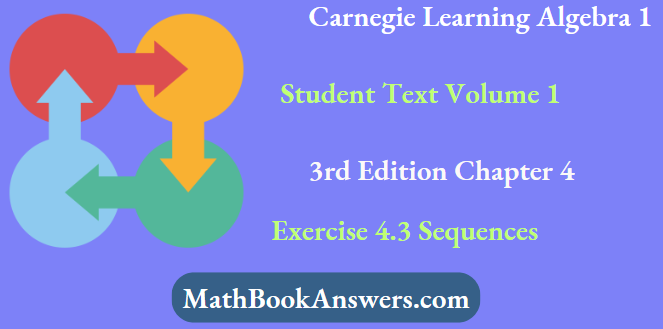
How To Solve Sequences Exercise 4.1
Carnegie Learning Algebra I Student Text Volume 1 3rd Edition Chapter 4 Exercise: 4.3 Sequences Page 236 Problem 2 Answer
We have given the sequence which represents the possible dollar amounts that Rico could donate for the season125,143,161,179,….
We have to determine the common ratio or common difference for the given sequence.
We solve this by using mathematical operations.
From question 1 part (a), we know that the sequence is arithmetic. So, we find here the common difference.
The given sequence is 125,143,161,179,…
If we subtract 125 from 143 we get 143−125=18
Now, we further do the same which numbers in the sequence i.e. 161−143=18, and 179−161=18 and so on.
From here we see that the common difference between the numbers in the sequence is d=18.
The common difference between the numbers of given sequence125,143,161,179,…is 18 .
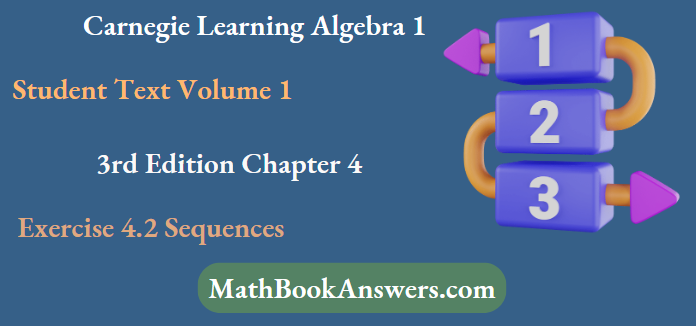
Page 236 Problem 3 Answer
We have given the sequence which represents the possible dollar amounts that Rico could donate for the season125,143,161,179,….
We also have given a table.
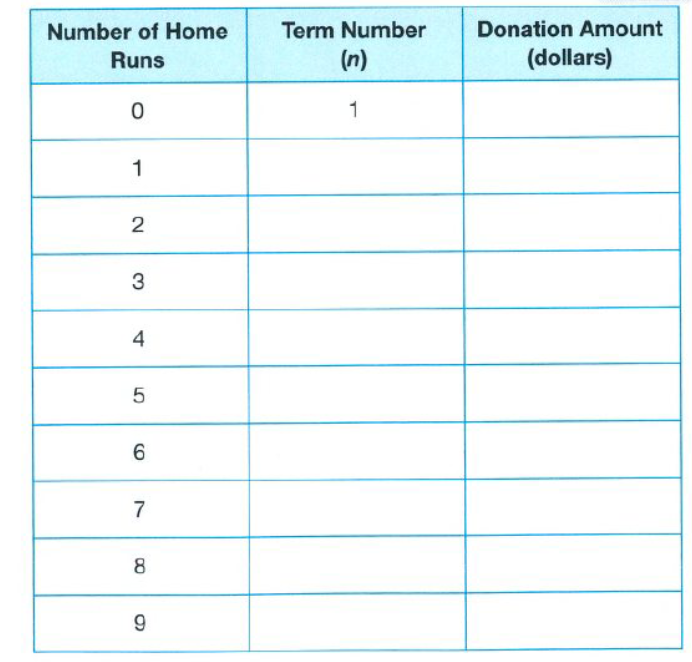
Here, we have to complete the table of values by using the number of home runs and the total dollar amount Rico could donate to the baseball team.
We use question 1 part (b) to solve this.
From question 1 part (b) we know that the common difference is18.
For the term numbers, each one is 1 more than the number of home runs.
We write the first 4 given terms of 125,143,161, and 179 as the first four values of the donation amounts and add 18 to each term to find the next terms.
So, the table is
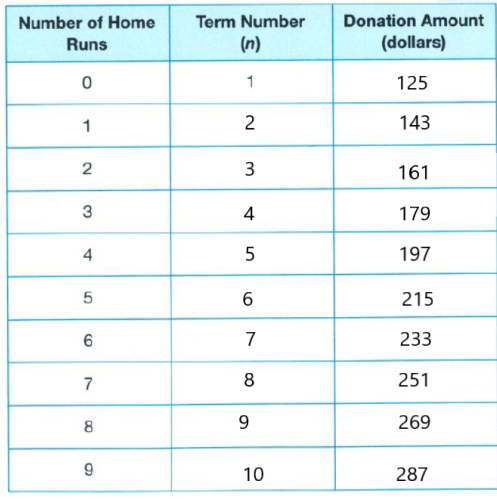
The table which shows the number of home runs, term numbers, and donation amount is shown below.
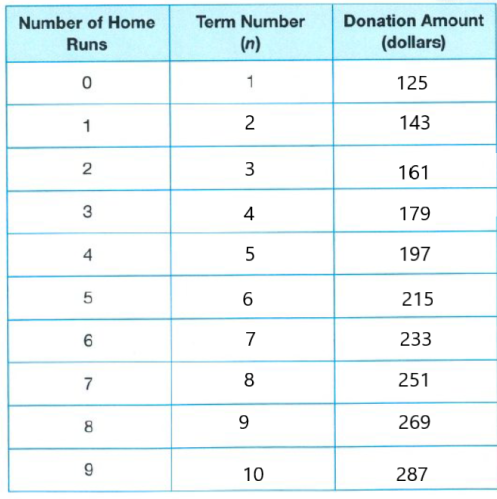
Page 236 Problem 4 Answer
We have given the sequence which represents the possible dollar amounts that Rico could donate for the season125,143,161,179,….
We have to explain how we can calculate the tenth term based on the ninth term.
From question 1 part (b), we know that the common difference d=18.
So, to find the tenth term based on the ninth term, we add 18 to the ninth term since the common difference is 18.
The tenth term can be calculated by adding the common difference to the ninth term.
Page 236 Problem 5 Answer
We have given the sequence which represents the possible dollar amounts that Rico could donate for the season 125,143,161,179,…
We have to determine the 20th term and explain our calculation.Here, we use question 1 part (b).
From question 1 part (b) we know that the common difference is18.
So, Here to find any term we take the number of times 18s added is equal to 1 less than the term number.
Therefore, the 20th term can be found by adding 18 to125 nineteen times.
This gives 125+18(19)=125+342=467
The 20th term of the given sequence125,143,161,179,… is 467.
Sequences Chapter 4 Exercise 4.3 Answers
Carnegie Learning Algebra I Student Text Volume 1 3rd Edition Chapter 4 Exercise: 4.3 Sequences Page 236 Problem 6 Answer
We have given the sequence which represents the possible dollar amounts that Rico could donate for the season125,143.161,179,…
We have to tell is there a way to calculate the 20th term without first calculating the 19th term and explain it.
Here, we use question 1 part (b).
Yes, there is a way to calculate the 20th term without first calculating 19th term, which is using the common difference d=18.
Therefore, the 20th term can be found by adding 18 to 125 nineteen times.
This gives
125+18(19)=125+342
=467
The 20th term without first calculating the 19th term is, which is by using the common difference d=18, and by adding the one less than the term number.
Page 236 Problem 7 Answer
We have given the sequence which represents the possible dollar amounts that Rico could donate for the season125,143,161,179,…
We have to describe the strategy to find 93rd term.Here, we use question 1 part (b).
From question 1 part (b) we know that the common difference is18.
So, Here to find any term we take the number of times 18 is added is equal to 1 less than the term number.
Therefore, the 93rd term can be found by adding 18 to 92 times.
This gives 125+18(92)=125+1656=1781.
The 93rd term of the given sequence 125,143,161,179,… is 1781.
Page 238 Problem 8 Answer
In this question, the given table is:

We have to find what is a3 in the sequence representing Rico’s possible donation amount. Here, firstly we make a sequence.
From the given table we make a sequence which is in the order a1,a2,a3,…
Thus, the sequence is125,143,161,179,…
Here, a3 represents the third term of the sequence so for the sequence 125,143,161,179,…a3=161
Since 161 is the third term.
From the given table, the a3 is the third term which is 161 in the sequence which represents Rico’s possible donation amount
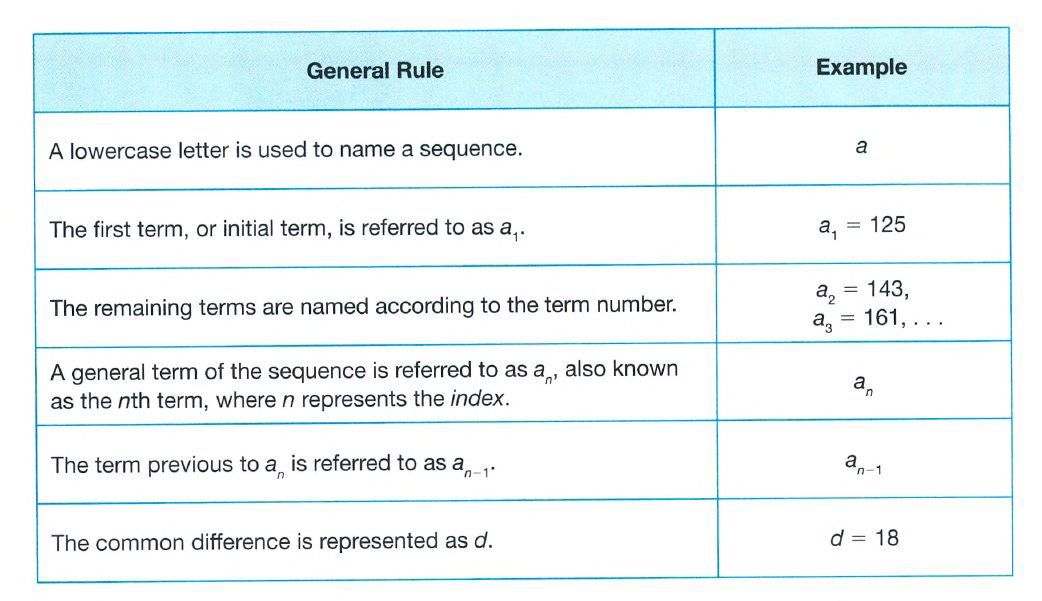
Page 239 Problem 9 Answer
In this question, we have given that 35 home runs.
We have to determine the amount of money Rico will contribute if the Centipedes hit.
We use the explicit formula to solve this.
Here, we take the sequence from question 2.
The explicit formula for an arithmetic sequence is an=a1+(n−1)d
where a1 is the first term, n is the term number, and d is the common difference.
From question 2 the sequence is125,143,161,179,…the first term is a1=125 and the common difference is d=18 so the explicit formula is: an
=a1+(n−1)d
=125+(n−1)(18)
=125+18n−18
=18n+107
As we know, the term number is 1 more than the number of home runs so for 35 home runs, n=36.
We substitute each value of n into the explicit formula an=18n+107 to find the amount of money Rico contributed:
a36=18(36)+107
=648+107
=755
The amount of money Rico will contribute if the Centipedes hit 35 home runs is 755.
Carnegie Learning Algebra I Sequences Exercise 4.3 Solutions
Carnegie Learning Algebra I Student Text Volume 1 3rd Edition Chapter 4 Exercise: 4.3 SequencesPage 239 Problem 10 Answer
In this question, we have given 48 home runs.
We have to determine the amount of money Rico will contribute if the Centipedes hit.
We use the explicit formula to solve this.
Here, we take the sequence from question 2.
The explicit formula for an arithmetic sequence is an
=a1+(n−1)d
where a1 is the first term, n is the term number, and d is the common difference.
From question 2 the sequence 125,143,161,179,…the first term is a1=125 and the common difference is d=18 so the explicit formula is:
an=a1+(n−1)d
=125+(n−1)(18)
=125+18n−18
=18n+107
As we know, the term number is 1 more than the number of home runs so for 48 home runs, n=49.
We substitute each value of n into the explicit formula an=18n+107 to find the amount of money Rico contributed:
a49=18(49)+107
=882+107
=989
The amount of money Rico will contribute if the Centipedes hit 48 home runs is 989.
Page 239 Problem 11 Answer
In this question, we have given 86 home runs.
We have to determine the amount of money Rico will contribute if the Centipedes hit.
We use the explicit formula to solve this.
Here, we take the sequence from question 2.
The explicit formula for an arithmetic sequence is an=a1+(n−1)d
where a1 is the first term, n is the term number, and d is the common difference.
From question 2 the sequence 125,143,161,179,… the first term is a1=125 and the common difference is d=18 so the explicit formula is:
an=a1+(n−1)d
=125+(n−1)(18)
=125+18n−18
=18n+107
As we know, the term number is 1 more than the number of home runs so for 86 home runs, n=87.
We substitute each value of n into the explicit formula an=18n+107 to find the amount of money Rico contributed:
a87=18(87)+107
=1566+107
=1673
The amount of money Rico will contribute if the Centipedes hit 86 home runs is 1673.
Carnegie Learning Algebra I Student Text Volume 1 3rd Edition Chapter 4 Exercise: 4.3 SequencesPage 239 Problem 12 Answer
In this question, we have given that 214 home runs.
We have to determine the amount of money Rico will contribute if the Centipedes hit.
We use the explicit formula to solve this.
Here, we take the sequence from question 2.
The explicit formula for an arithmetic sequence is an=a1+(n−1)d where a1 is the first term, n
is the term number, and d is the common difference.
From question 2 the sequence 125,143,161,179,… the first term is a1=125 and the common difference is d=18 so the explicit formula is:
an=a1+(n−1)d
=125+(n−1)(18)
=125+18n−18
=18n+107
As we know, the term number is 1 more than the number of home runs so for 214 home runs, n=215.
We substitute each value of n into the explicit formula an=18n+107 to find the amount of money Rico contributed:
a215=18(215)+107
=3870+107
=3977
The amount of money Rico will contribute if the Centipedes hit 214 home runs is 3977.
Page 240 Problem 13 Answer
We are given that Rico decided to contribute $500 and will donate $75.00 for every home run the Centipedes hit.
We are required to determine Rico’s contribution if the Centipedes hit 11 home runs.
Here, we will solve this by using the definition of Arithmetic Sequence.
If he contributed $500 for zero home runs, then a{1}=500.
If he contributes $75.00 for each home run, then d=75.
Then, by the formula of an arithmetic sequence, we get,
an=a1+(n−1)d
=500+(n−1)(75)
=500+75n−75
=75n+425
The term number is 1 more than the number of hits.
Hence, for each home run we take the corresponding n value and substitute each value of n into the explicit formula to find the amount he contributes, as,
a12=75(12)+425
=900+425
=1325
Rico’s contribution if the Centipedes hit 11 home runs is $1325, which is obtained using the formula for arithmetic sequence.
Exercise 4.3 Sequences Explained
Carnegie Learning Algebra I Student Text Volume 1 3rd Edition Chapter 4 Exercise: 4.3 Sequences Page 240 Problem 14 Answer
We are given that Rico decides to contribute $500 and will donate $75.00 for every home run the Centipedes hit.
We are required to determine Rico’s contribution if the Centipedes hit 26 home runs.
Here, we will solve this by using the definition of Arithmetic Sequence.
If he contributed $500 for 0 home runs, then a{1}=500.
If he contributes $75.00 for each home run, then d=75.
The explicit formula by the arithmetic sequence definition is,
an=a1+(n−1)d
=500+(n−1)(75)
=500+75n−75
=75n+425
The term number is 1 more than the number of hits.
Hence, for each home run we take the corresponding n value and substitute each value of n into the explicit formula to find the amount he contributes, as,
a27=75(27)+425
=2025+425
=2450
Rico’s contribution if the Centipedes hit 26 home runs is $2450, which is obtained using the formula for arithmetic sequence.
Page 240 Problem 15 Answer
We are given that Rico decides to contribute $500 and will donate $75.00 for every home run the Centipedes hit.
We are required to determine Rico’s contribution if the Centipedes hit39
home runs.Here, we will solve this by using the definition of Arithmetic Sequence.
If he contributed $500 for 0 home runs, then a{1}=500.
If he contributes $75.00 for each home run, then d=75.
The explicit formula by the arithmetic sequence definition is,
an=a1+(n−1)d
=500+(n−1)(75)
=500+75n−75
=75n+425
The term number is 1 more than the number of hits.
Hence, for each home run we take the corresponding n value and substitute each value of n into the explicit formula to find the amount he contributes:
a40=75(40)+425
=3000+425
=3425.
Rico’s contribution if the Centipedes hit 39 home runs is $3425, which is obtained using the formula for an arithmetic sequence.
Page 240 Problem 16 Answer
We are given that Rico decides to contribute $500 and will donate $75.00 for every home run the Centipedes hit.
We are required to determine Rico’s contribution if the Centipedes hit50
home runs. Here, we will solve this by using the definition of Arithmetic Sequence.
If he contributed $500 for 0 home runs, then a{1}=500.
If he contributes $75.00 for each home run, then d=75.
The explicit formula by the arithmetic sequence definition is,
an=a1+(n−1)d
=500+(n−1)(75)
=500+75n−75
=75n+425
The term number is 1 more than the number of hits.
Hence, for each home run we take the corresponding n value and substitute each value of n into the explicit formula to find the amount he contributes:
a51=75(51)+425
=3825+525
=4250.
Rico’s contribution if the Centipedes hit 50 home runs is $4250, which is obtained using the formula for arithmetic sequence.
Carnegie Learning Algebra I Student Text Volume 1 3rd Edition Chapter 4 Exercise: 4.3 Sequences Page 240 Problem 17 Answer
We are given that Rico decides to contribute $500 and will donate $75.00 for every home run the Centipedes hit.
We are required to write the first 10 terms of the sequence representing the new contribution.
Here, we will solve this by using the definition of Arithmetic Sequence.
We know that the given sequence is an arithmetic sequence and hence each term differs by a common constant.
The terms are increasing by 75 each time so the first ten terms can be given by,
The terms are increasing by 75 each time500,575,650,725,800,875,950,1025,1100,1175, which is obtained using the formula for arithmetic sequence.
Page 240 Problem 18 Answer
We are given the sequence which represents the growth of eukaryotic cells: 1,2,4,8,16,…
We are required to describe why the sequence is geometric. Here, we will use the definition of Geometric Sequence.
The sequence is geometric, since we can find a common ratio, given by,
2/1=4/2=8/4
=16/8
=2.
The given sequence 1,2,4,8,16,….is geometric because they have a common ratio 2.
Page 240 Problem 19 Answer
We are given the sequence that represents the growth of eukaryotic cells: We are required to determine the common ratio of the sequence.
Here, we will use the definition of Geometric Sequence.
In this given sequence,
a{1}=1,
a{2}=2
Now, the common ratio,
r=a{2}/a{1}
=2/1
=2
We already proved in the previous section that it is true for all members of the sequence. (refer previous exercise)
The common ratio of the given sequence of growth of eukaryotic cells, 1,2,4,8,16,…, is 2.
Page 240 Problem 20 Answer
We are given the sequence of the growth of cells following a geometric sequence. We are required to determine total number of cells after each division and complete the given table.
Here given 1st term a{1}=1 and 2nd terma{2}=2 and so on.
First we know, the common ratio r=2. (refer previous exercise)
Hence, applying the formula for the terms of a geometric sequence, we get the number of cells as,
a{1}=1a2=a1×r2−1
=1×21
=2
Similarly,
a{3}=1×22=4
a4=1×23=8 and,
a5=1×24=16
a{6}=1×25=32
Continuing, we get,
a7=1×26=64
a8 =1×27=128and,
a9=1×28=256
a10=1×29=512
Using these values, we get the table as,
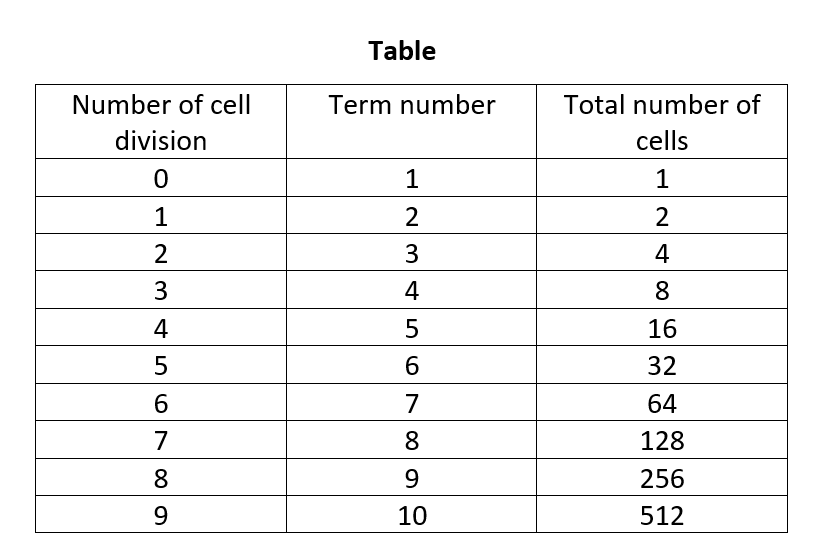
Using the number of cell divisions to identify the term number, and the total number of cells after each division, we get the sequence as,
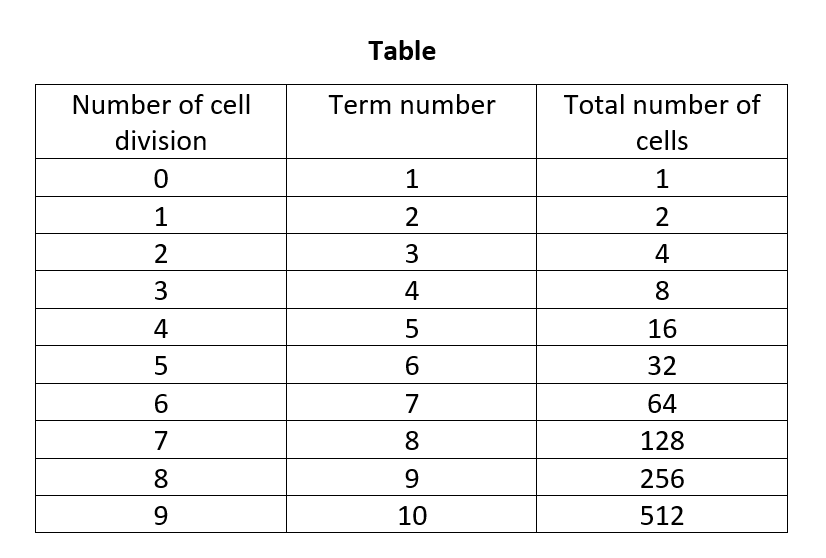
Carnegie Learning Algebra I Student Text Volume 1 3rd Edition Chapter 4 Exercise: 4.3 Sequences Page 240 Problem 21 Answer
We are given the sequence of growth of cells as 1,2,4,8,16…
We are required to find out tenth term based on the ninth term.
Here, we will use the formula for general term of geometric sequence.
We have the 9th term as,a9=a8×2
=128×2
=256
Now, the 10th term using the formula is,
a10=a9×2
=256×2
=512
The tenth term based on the ninth term is 512, which is obtained using the formula for the general term of a geometric sequence.
Page 240 Problem 22 Answer
We are given the sequence of growth of eukaryotic cells.
We are required to determine the 20th term and explain the calculation.
Here, we will use the definition of a geometric sequence.
We can say that the number of times that two has been multiplied by the first term of the sequence, that is 1, is one less than the term number.
Hence, the 20th term will have 2 multiplied 19 times, which is given by,
1(2){19}
=524,288.
The 20th term of this sequence is 524,288=(2){19}, which is obtained using the common ratio.
Page 240 Problem 23 Answer
We are given the sequence of the growth of eukaryotic cells.
We are required to find a way to calculate the 20th term without first calculating the 19th term and describe the strategy.
Here, we will explain the previous exercise process.
Yes, there is a way to calculate the 20th term without first calculating the 19th term, which is using the common ratio, r=2, and raising it to the power one less than the term number.
20th term =2{19}=524,288
The 20th term without first calculating the 19th term is 524,288, which is by using the common ratio, r=2, and raising it to the power one less than the term number.
Page 243 Problem 24 Answer
We are given a sequence of the growth of eukaryotic cells.
We are required to determine the total number of cells after 11 divisions.
Here, we will use the formula for the nth term in a geometric sequence.
As we know that the given sequence is geometric, we substitute the value of n=12 in the formula, to get,
g12=g1×r12−1
=1×211
=2{11}
=2048
The total number of cells after 11 divisions is 2048, which is obtained by substitution in the general formula for geometric sequence.
Page 243 Problem 25 Answer
We are given a sequence of the growth of eukaryotic cells.
We are required to determine the total number of cells after 14 divisions.
Here, we will use the formula for the nth term in a geometric sequence.
As we know that the given sequence is geometric, we substitute the value of n=15 in the formula, to get,
g15=215−1
=214
=16,384
The total number of cells after 14 divisions is 16,384, which is obtained by substitution in the general formula for geometric sequence.
Carnegie Learning Algebra I Student Text Volume 1 3rd Edition Chapter 4 Exercise: 4.3 Sequences Page 243 Problem 26 Answer
We are given a sequence of the growth of eukaryotic cells.
We are required to determine the total number of cells after 18 divisions.
Here, we will use the formula for the nth term in a geometric sequence.
As we know that the given sequence is geometric, we substitute the value of n=19, to get,
g19=g1×r19−1
=219−1
=218
=262,144
The total number of cells after 18 divisions is 262,144, which is obtained by substitution in the general formula for geometric sequence.
Page 243 Problem 27 Answer
We are given a sequence of the growth of eukaryotic cells.
We are required to determine the total number of cells after 22 divisions.
Here, we will use the formula for nth term in a geometric sequence.
As we know that the given sequence is geometric, we substitute the value of n=23,
g23=g1×r23−1
=223−1
=222
=4,194,304
The total number of cells after 22 divisions is 4,194,304, which is obtained by substitution in the general formula for geometric sequence.
Chapter 4 Exercise 4.3 Carnegie Learning Guide
Carnegie Learning Algebra I Student Text Volume 1 3rd Edition Chapter 4 Exercise: 4.3 Sequences Page 244 Problem 28 Answer
We are given that a scientist has 5 eukaryotic cells in a petri dish and each mother cell divides into 3 daughter cells.
We are required to find out the total number of cells in petri dish after four division.
We have to remember that the 1st term in this sequence is the total number of cells after 0 division.
So, the 5th term represents the total number of cells after 4 divisions.
As the scientist starts with 5 cells, then a1=5, and each cell divides into 3 cells, then the common ratio is r=3.
Now, by the formula, we find out,
that a5=a1×r5−1
=5(3)5−1
=5(81)
=405
The total number of cells in the petri dish after four divisions is 405, which is obtained by substitution in the general formula for a geometric sequence.
Page 244 Problem 29 Answer
We are given that a scientist has 5 eukaryotic cells in a petri dish and each mother cell is divided into 3 daughter cells.
We are required to find out the total number of cells in a petri dish after seven divisions.
We have to remember that the 1st term in this sequence is the total no. of cells after 0 division.
so, the 8th term represents the total number of cells after 7 divisions.
As the scientist starts with 5 cells, then a1=5, and each cell divides into 3 cells, then the common ratio is r=3.
Now, by the formula, we find out,
a8=a1×r8−1, to get,
a8=5(3)8−1
=5(3)7
=5(2187)
=10,935
The total number of cells in the petri dish after seven divisions is 10,935, which is obtained by substitution in the general formula for a geometric sequence.
Page 244 Problem 30 Answer
We are given that a scientist has 5 eukaryotic cells in a petri dish and each mother cell is divided into 3 daughter cells.
We are required to find out the total number of cells in a petri dish after 13 divisions.
Here, we should remember that the first term in this sequence is the total number of cells after zero division so, the 14th term represents the total number of cells after 13 divisions.
As the scientist starts with 5 cells, then a1=5, and each cell divides into 3 cells, then the common ratio is r=3.
Now, by the formula, we find out,a14=5×313, to get,
a14=5(3)14−1
=5(3)13
=5(1,594,323)
=7,971,615
The total number of cells in the petri dish after 13division is 7,971,615, which is obtained by substitution in the general formula for a geometric sequence.
Page 244 Problem 31 Answer
We are given that a scientist has 5 eukaryotic cells in a petri dish and each mother cell is divided into 3 daughter cells.
We are required to find out the total number of cells in a petri dish after 16 divisions.
Here, we should remember that the first term in this sequence is the total no. of cells after 0 division, so the 17th term represents the total no. of cells after 16 divisions.
As the scientist starts with 5 cells, then a1=5, and each cell divides into 3 cells, then the common ratio is r=3.
Now, by the formula, we find out,
a17=5(3)17−1
=5(3)16
=5(43,046,721)
=215,233,605
The total number of cells in the petri dish after 16 divisions is215,233,605, which is obtained by substitution in the general formula for a geometric sequence.
Carnegie Learning Algebra I Student Text Volume 1 3rd Edition Chapter 4 Exercise: 4.3 Sequences Page 244 Problem 32 Answer
We are given that a scientist has 5 eukaryotic cells in a petri dish and each mother cell is divided into 3 daughter cells.
We are required to find the sequence of the first 10th term for the scientist’s hypothesis.
Here, we should remember that the first term of the sequence is the total number of cells after 0 division.
By formula, we can find each term of the sequence as,
First term,a{1}=5
Second term,a2
a2/=a1×r2−1
=5×31/15
The third term as,
a3=a1×r3−1
a3=5×32
=45
Fourth term as,
a4=5×33=135
The fifth term as,
a5=5×34=405
Sixth term,
a6=5×35=1215
Seventh term as,
a7=5×36=3645
Eighth term,
a8=5×37=10,935
Ninth term
a9=5×38=32,805
Tenth term
a10=5×39=98,415
The first 10 terms of the sequence for the scientist’s hypothesis is .15,45,135,405,1215,3645,10935,32805,98415, which is obtained by substitution in the general formula for geometric sequence.
Page 246 Exercise 1 Answer
We are given a sequence 5/3,5,15,45 We have to determine whether the sequence is arithmetic or geometric.
We have to find the unknown term of this sequence by using a recursive formula.
Here1st,2nd,3rd…term are represented as a{1},a{2},a{3}….
First, we will find the common ratio of the given sequence
Common ratio
r=5/(5/3)=3and
r=15/5=3 also
r=45/15=3
The sequence is geometric with a common ratio of 3.
Now, we will use the recursive formula for this sequence,
The unknown term is a5.
5th terma5=a5−1×r/a5
=a4×r
=45×3
=135
The sequence is geometric with a common ratio of 3.
The unknown term is 135.
The sequence is 5/3,5,15,45,135.
Page 246 Exercise 2 Answer
We are given a sequence of −45,−61,−77,−93
We have to check whether the sequence is arithmetic or geometric.
We have to find the unknown term of this sequence by using the Recursive formula. Here 1st,2nd,3rd……are represented as a{1},a{2},a{3}……
First, we have to find the common difference,
Common difference d
=−61+45
=−16
d=−77+61
=−16
d=−93+77
=−16
The sequence is arithmetic with the common difference of −16.
The unknown term is a5, so using the Recursive formula.
5th term a{5}=a{5−1}+d
a{5}=a{4}+d
=−93+(−16)
=−93−16
=−109
The sequence is Arithmetic with a common difference of −16.
The unknown term is −109.
The sequence is −45,−61,−77,−93,−109.
Page 246 Exercise 3 Answer
We are given the sequence −3,1,9,13,….
We have to find whether the sequence is arithmetic or geometric.
We will use the recursive formula an=an−1+d.
We will find the difference between d,
1−(−3)=4
13−9=4
The sequence is arithmetic with a common difference of d=4.
The recursive formula for an arithmetic sequence is an=an−1+d.
So, the recursive formula for this sequence is an=an−1+4.
The unknown term is a3, so using the recursive formula and a2=1
a3=a2+4
a3=1+4
a3=5
The sequence is arithmetic with the common difference 4.
The unknown term is a3=5.
Sequence is −3,1,5,9,13,…
Page 246 Exercise 4 Answer
We are given a sequence −111,222,……,888,−1776,…
We have to find whether the sequence is arithmetic or geometric.
Then we will find the unknown term.We will use the recursive formula an
=an−1.r.
First, we have to find a Common ratio
r=a{2}/a{1}
r=−222/111
=−2
r=a{5}/a{4}
r=−1776/888
=−2
The sequence is geometric with a common ratio of r=−2.
Now we will use the recursive formula for this sequence,
an=an−1.−2
The unknown term is a3
so using the recursive formula and a2=222.
Third term a3=a3−1×r
a3=a3×r
=222×(−2)
=−444
The sequence is geometric with a common ratio of r=−2.
The unknown term is a3=−444.
The sequence is −111,222,−444,888,−1776,…
Page 246 Exercise 5 Answer
We are given a sequence −30,−15,−3.75,−1.875,…
We have to find whether the sequence is arithmetic or geometric.Then we will find the unknown term
First, we have to find a common ratio,
r=a2/a1
=15/30
=1/2
r=a4
a3=−1.875−3.75
=1/2
The sequence is geometric with a common ratio of 1/2.
Now we will use the recursive formula for this sequence,
an=an−1×1/2
The unknown terms on the sequence are a3 and a6, so using the recursive formula, gives a2
=−15,a5
=1.875gives
a3=a2and a6=a5
a3=a2×1/2
=−15×1/2
a3=−15×1/2
a3=−7.5
Also,a6=a5×1/2
a6=−1.875×1/2
a6=−0.9375
The given sequence is geometric with a common ratio 1/2.
The unknown terms are a3
=−0.75,a6
=−0.9375.
The sequence is −30,−15,−3.75,−1.875,−7.5,−0.9375.
Page 246 Exercise 6 Answer
We are given a sequence 3278,2678,2078,….
We have to find whether the sequence is arithmetic or geometric.
We will then find the unknown terms.We will use
First, we have to find the common difference,
d=a{2}−a{1}
=2678−3278
=−600
d=a{3}−a{2}
=2078−2678
=−600
The sequence is arithmetic with a common difference of −600.
The unknown terms are a4,a5,a6, so using the recursive formula and a3
=2078
Gives,a{4}=a{4−1}+d
a{4}=a{3}+d
=2078+(−600)
=2078−600
=1478 and
a{5}=a{5−1}+d
a{5}=a{4}+d
=1478+(−600)
=1478−600
=878
also a{6}=a{6−1}+d
a{6}=a{5}+d
=878+(−600)
=878−600
The given sequence is arithmetic with a common difference of 600.
The unknown terms are 1478,878,278.
The sequence is3278,2678,2078,1478,878,278.
Carnegie Learning Algebra I Student Text Volume 1 3rd Edition Chapter 4 Exercise: 4.3 Sequences Page 247 Exercise 7 Answer
We are given a sequence 3278,2678,2078,……
We have to determine the 9th term of this sequence by using recursive formula.Here 1st,2nd,3rd….. terms are represented as a{1},a{2},a{3}…..
From Question 1 part (f), the next three terms of the sequence are 1478,878,278.
First, we will find the common difference,
Common difference
d=a{2}−a{1}
=2678−3278
=−600 and
d=a{3}−a{2}
=2078−2678
=−600
We will use the recursive formula an=an−1−600
Now, using a recursive formula
a{6}=a{5}+d
=878−600
=278
also a{7}=a{6}+d=278−600
=−322
also a{8}=a{7}+d
=−322−600
=−922
and a{9}=a{8}+d
=−922−600
=−1522
The 9th term of this sequence by using a recursive formula is −1522.
Page 247 Exercise 8 Answer
We are given a sequence 3278,2678,2078…
We have to find out the 9th term of this sequence by an explicit formula.Here 1st,2nd,3rd……terms are represented as a{1},a{2},a{3}…..
First, we will find the common difference,
d=a{2}−a{1}
=2678−3278
=−600
and d=a{3}−a{2}
=2078−2678
=−600
We will use explicit formulas an
=a1+(n−1)d.
n=y
a1=3278
d=-600
By substituting the values,
We can find, 9th term a9
=a1+(9−1)×d
=3278+8×(−600)
=3278−4800
=−1522
The 9th term of this sequence by explicit formula is −1522.
Page 247 Exercise 9 Answer
We are given sequence 3278,2678,2078……
We have to explain which formula is best for finding the nth term of this sequence.
I prefer to use the explicit formula because it requires fewer steps as compared to the recursive formula.
Using the recursive formula requires finding the seventh and eighth terms before I can find the ninth term.
With the explicit formula, I only need the first term and common difference to find the ninth term.
I prefer the explicit formula for this sequence because it’s more convenient to use.
Page 247 Exercise 10 Answer
We are given an arithmetic sequence 3278,2678,2078…till the nth term.
We have to explain which formula will we use if we want to determine the 61st term of the sequence.
I would use the explicit formula to find the term of the sequence.
If I used the recursive formula, I would have to find the first 60 terms before I could find the61st
term. Using the explicit formula only requires the first term and the common difference.
I would use the explicit formula because it’s more convenient to use.
How To Solve Sequences Exercise 4.3
Carnegie Learning Algebra I Student Text Volume 1 3rd Edition Chapter 4 Exercise: 4.3 Sequences Page 248 Exercise 11 Answer
We have to find the 20th term of the sequence t.
We can use a graphing calculator to generate terms in sequence using recursive formula.
To find the answer I determine the following steps given in the book. I entered 3 and then pressed ENTER.
Then I hit+7 and hit ENTER since the common difference is 7.
This gave me the second term.
I then pressed ENTER 18 times to get the 20th term and the calculator gave me 136 .
After using the methods given in the book the 20th term is 136.
Page 249 Exercise 12 Answer
We have to find out does our solution using this method matches our solution in Question 3.
We can use a graphing calculator to generate two sequences at the same time to determine a certain term in a sequence.
Using the steps in the book, hit2ND and then ( to get the first bracket.
Type1,3 and then hit 2NDand ) to get the second brackets.
Our calculator should show{1,3} to represent the first term being 3.
Then press ENTER. The output should be{1,3}.
Press 2ND ( to get a left bracket.
Then press 2ND (-) to get Ans to display. Type(1)+1, to tell it to add 1 to the first value of {1,2}.
Press2ND(−) again to get Ans to display a second time.
Then type (2)+7 to tell the calculator the second value of{1,2} must increase by 7.
Press 2ND) to get the right bracket. Calculator should show {Ans(1)+1,Ans(2)+7}.
Then press ENTER. Calculator should show output {2,10}.
Press ENTER repeatedly until it outputs {20136}.
The 20th term is then 136 which is the same answer s Question 3.
Yes, our solution using this method matches our solution in Question 3.
Page 250 Exercise 13 Answer
We have to find the7th term of the sequence 6,14,22,…
We can use a graphing calculator to generate terms in sequence using recursive formula.
According to book page number 249, the explanation is given, to find the answer I determine the following steps given in the book.
I entered 3 and then pressed ENTER. Then I hit+7 and hit ENTER since the common difference is 7.
This gave me the second term. I then pressed ENTER18 times to get the 20th term and the calculator gave me136.
Using the above steps in the explanation, With a first term of 6 and a common difference of 8 gives{16},{214},{322},{430},{538},{646},{754}.
Seventh term of arithmetic sequence 6,14,22… is 54 obtained by the graphing method.
Page 250 Exercise 14 Answer
We have to find first ten term of the sequence 54,47,40,…
We can use a graphing calculator to generate terms in sequence using recursive formula.
According to book page number 249, this explanation is given, to find the answer I determine the following steps given in the book. I entered 3 and then pressed ENTER.
Then I hit+7 and hit ENTER since the common difference is.
This gave me the second term.
I then pressed ENTER 18 times to get the 20th term and the calculator gave me 136.
Using the above steps in the explanation, With a first term of 54 and a common difference of−7 gives{1,54},{2,47},{3,40},{4,33},{5,26},{6,19},{7,12},{8,5},{9,−2}and{10,−9}
so the first ten terms are 54,47,40,33,26,19,12,5,−2,−9.
First ten terms of the sequence are 54,47,40,33,26,19,12,5,−2,−9
Carnegie Learning Algebra I Student Text Volume 1 3rd Edition Chapter 4 Exercise: 4.3 Sequences Page 250 Exercise 15 Answer
We are a given,
t1=8
Tn =t{n−1}+19
We have to list the first 10 terms of the arithmetic sequence generated by the recursive formula.
According to book page number 249, this explanation is given, to find the answer I determine the following steps given in the book. I entered 3 and then pressed ENTER.
Then I hit+7 and hit ENTER since the common difference is. This gave me the second term. I then pressed ENTER 18 times to get the 20th term and the calculator gave me 136.
Using the above steps in the explanation, With a first term of 8and a common difference of 19 gives{1,8},{2,27},{3,46},{4,64},{5,84},{6,103},{7,122},{8,141},{9,160}and{10,179}.
So the first ten terms are 8,27,46,65,84,103,122,141,160,179.
First ten terms of the sequence are 8,27,46,65,84,103,122,141,160,179
Page 250 Exercise 16 Answer
We are given a sequence 45,51,57,…We have to identify the 30th term.
We can use a graphing calculator to generate terms in sequence using recursive formula.
According to book page number 249, this explanation is given, to find the answer I determine the following steps given in the book.
I entered 3 and then pressed ENTER. Then I hit+7 and hit ENTER since the common difference is.
This gave me the second term. I then pressed ENTER 18 times to get the 20th term and the calculator gave me136 .
Using the above steps in the explanation, With a first term of 45 and a common difference of 6 gives {30 219} so the 30th term is 219.
The 30th term of the arithmetic sequence is 219.
Page 250 Exercise 17 Answer
In the question we have been asked to explain the advantages and disadvantages of using the recursive formula.
We can say, advantages of Recursive Formula is that the formula may is easier to write.
We can also say that it reduces unnecessary calling of function.
We can say that it is extremely useful when applying the same solution.
We can say that disadvantages of Recursive Formula is that recursive formulas are generally slower than non-recursive formulas.
We can say that it is not more efficient in terms of space and time complexity.
So, we wrote about the advantages of recursive formula that it is easier to write, and reduces calling function and is useful when applying to same solution, and wrote its disadvantages that it is slower than non-recursive formulas and is not efficient for space and time complexity.
